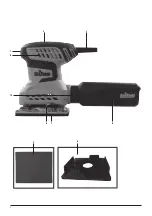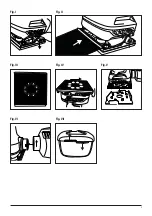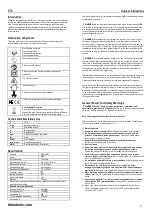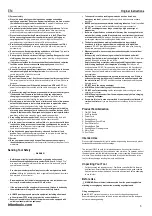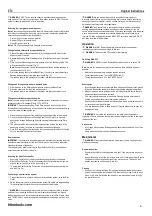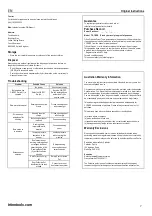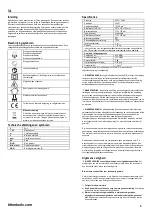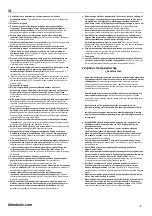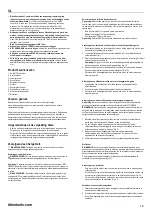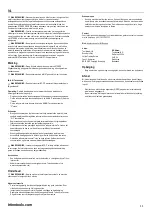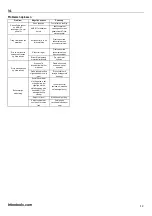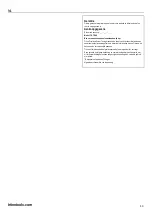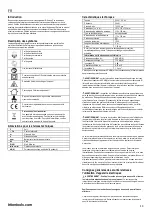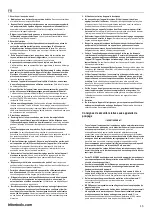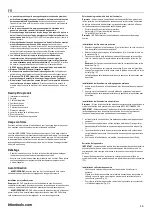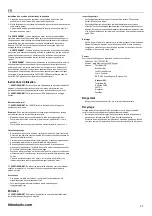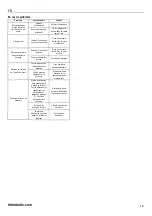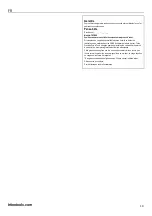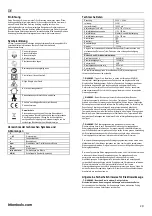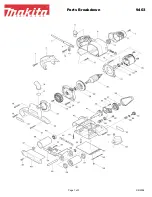
EN
Original Instructions
tritontools.com
5
3) Personal safety
a)
Stay alert, watch what you are doing and use common sense when
operating a power tool. Do not use a power tool while you are tired or under
the influence of drugs, alcohol or medication.
A moment of inattention while
operating power tools may result in serious personal injury.
b)
Use personal protective equipment. Always wear eye protection.
Protective
equipment such as a dust mask, non-skid safety shoes, hard hat or hearing
protection used for appropriate conditions will reduce personal injuries.
c)
Prevent unintentional starting.
Ensure the switch is in the OFF-position
before connecting to power source and/or battery pack, picking up or
carrying the tool.
Carrying power tools with your finger on the switch or
energising power tools that have the switch ON invites accidents.
d)
Remove any adjusting key or wrench before turning the power tool ON.
A
wrench or a key left attached to a rotating part of the power tool may result in
personal injury.
e)
Do not overreach. Keep proper footing and balance at all times.
This enables
better control of the power tool in unexpected situations.
f)
Dress properly. Do not wear loose clothing or jewellery. Keep your hair and
clothing away from moving parts.
Loose clothes, jewellery or long hair can be
caught in moving parts.
g)
If devices are provided for the connection of dust extraction and collection
facilities, ensure these are connected and properly used.
Use of dust
collection can reduce dust-related hazards.
h)
Do not let familiarity gained from frequent use of tools allow you to become
complacent and ignore tool safety principles.
A careless action can cause
severe injury within a fraction of a second.
4) Power tool use and care
a)
Do not force the power tool. Use the correct power tool for your application.
The correct power tool will do the job better and safer at the rate for which it was
designed.
b)
Do not use the power tool if the switch does not turn it ON and OFF.
Any
power tool that cannot be controlled with the switch is dangerous and must be
repaired.
c)
Disconnect the plug from the power source and/or remove the battery pack,
if detachable, from the power tool before making any adjustments,
changing accessories, or storing power tools.
Such preventive safety
measures reduce the risk of starting the power tool accidentally.
d)
Store idle power tools out of the reach of children and do not allow persons
unfamiliar with the power tool or these instructions to operate the power
tool.
Power tools are dangerous in the hands of untrained users.
e)
Maintain power tools and accessories. Check for misalignment or binding
of moving parts, breakage of parts and any other condition that may affect
the power tool’s operation. If damaged, have the power tool repaired before
use.
Many accidents are caused by poorly maintained power tools.
f)
Keep cutting tools sharp and clean.
Properly maintained cutting tools with
sharp cutting edges are less likely to bind and are easier to control.
g)
Use the power tool, accessories and tool bits, etc. in accordance with these
instructions, taking into account the working conditions and the work to be
performed.
Use of the power tool for operations different from those intended
could result in a hazardous situation.
h)
Keep handles and grasping surfaces dry, clean and free from oil and
grease.
Slippery handles and grasping surfaces do not allow for safe handling
and control of the tool in unexpected situations.
5) Service
a)
Have your power tool serviced by a qualified repair person using only
identical replacement parts.
This will ensure that the safety of the power tool is
maintained.
Sanding Tool Safety
WARNING!
•
Hold the power tool by insulated handles or gripping surfaces only,
because the sanding belt/sheet may contact its own cord.
Cutting a "live"
wire may make exposed metal parts of the power tool ‘live’ and could give the
operator an electric shock.
•
Use clamps or another practical way to secure the workpiece to a stable
platform.
Holding the workpiece by hand or against the body makes it unstable
and may lead to loss of control.
•
Recommendation that the tool always be supplied via a residual current
device with a rated residual current of 30 mA or less.
•
If the replacement of the supply cord is necessary, this has to be done by
the manufacturer or his agent in order to avoid a safety hazard.
a.
ALWAYS wear appropriate protective equipment, including a dust mask
with a minimum FFP2 rating, eye protection and ear defenders
b.
Ensure all people in the vicinity of the work area are also equipped with
suitable personal protective equipment
c.
Take special care when sanding some woods (such as beech, oak,
mahogany and teak),
as the dust produced is toxic and can cause extreme
reactions
d.
NEVER use to process any materials containing asbestos.
Consult a qualified
professional, if you are uncertain whether an object
contains asbestos
e.
DO NOT sand magnesium or alloys containing a high percentage of
magnesium
f.
Be aware of paint finishes or treatments that may have been applied to the
material that is being sanded. Many treatments can create dust that is toxic,
or otherwise harmful.
If working on a building constructed prior to 1960, there is
an increased chance of encountering lead-based paints
g.
The dust produced when sanding lead-based paints is particularly
hazardous to children, pregnant women, and people with high blood
pressure.
DO NOT allow these people near to the work area, even if wearing
appropriate personal protective equipment
h.
Whenever possible, use a vacuum dust extraction system to control dust
and waste
i.
Be especially careful when using a machine for both wood and metal
sanding. Sparks from metal can easily ignite wood dust.
ALWAYS clean your
machine thoroughly to reduce the risk of fire
j.
Empty the dust bag or container (where applicable) frequently during use,
before taking breaks and after completion of sanding.
Dust may be an
explosion hazard. DO NOT throw sanding dust into an open fire. Spontaneous
combustion may occur when oil or water particles come into contact with dust
particles. Dispose of waste materials carefully and in accordance with local laws
and regulations.
k.
Work surfaces and sandpaper can become very hot during use. If there is
evidence of burning (smoke or ash), from the work surface, stop and allow
the material to cool.
DO NOT touch work surface or sandpaper until they have
had time to cool
l.
DO NOT touch the moving sandpaper
m.
ALWAYS switch off before you put the sander down
n.
DO NOT use for wet sanding.
Liquids entering the motor housing can cause
severe electric shocks
o.
ALWAYS unplug the sander from the mains power supply before changing
or replacing sandpaper
p.
Even when this tool is used as prescribed it is not possible to eliminate all
residual risk factors.
If you are in any doubt as to safe use of this tool, do not
use it
Product Familiarisation
1. ON/OFF Switch
2. Soft Grip Handle
3. Power Cord
4. Sanding Sheets
5. Sanding Sheet Punch Plate
6. Dust Collection Pot
7. Sanding Base Plate
8. Sanding Sheet Clamping Levers
9. Motor Vents
10. Dust Outlet
Intended Use
Electric orbital sheet sander for light to medium duty sanding tasks on wood, plastic,
painted surfaces and other surface coatings.
The tool must ONLY be used for its intended purpose. Any use other than those
mentioned in this manual will be considered a case of misuse. The operator, and not
the manufacturer, shall be liable for any damage or injury resulting from such cases
of misuse. The manufacturer shall not be liable for any modifications made to the
tool, nor for any damage resulting from such modifications.
Unpacking Your Tool
• Carefully unpack and inspect your tool. Familiarise yourself with all its features
and functions. Ensure that all parts of the tool are present and in good condition
• If any parts are missing or damaged, have such parts replaced before attempting
to use this tool
Before Use
WARNING: Ensure the tool is disconnected from the power supply before
attaching or changing any accessories, or making any adjustments.
Fitting sanding sheets
Note:
DO NOT continue to use worn, torn, or heavily clogged sanding sheets.
Ensure foreign objects, such as nails and screws, are removed from the workpiece
before commencing sanding.
Summary of Contents for TQTRSS
Page 2: ...2 3 2 10 1 9 5 7 4 8 6...
Page 3: ...3 Fig II Fig I Fig III Fig V Fig IV Fig VI Fig VII...
Page 54: ...RU tritontools com 54 1 Triton 7 6...
Page 55: ...RU tritontools com 55...
Page 56: ......


